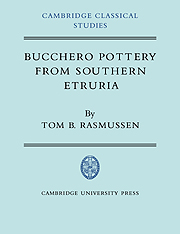APPENDIX: INSCRIPTIONS
Published online by Cambridge University Press: 05 June 2014
Summary
INSCRIPTIONS
GROUP 13:2 (FIG.426.1): mi aranth ramuthasi vestiricinala muluvanice
GROUP 7:3 (FIG.426.2): mi hirumesi mulu
GROUP 31:3 (FIG.426.3): tetaia
GROUP 39:10 (FIG.426.4): ve
GROUP 39:3 (FIG.426.5): venel
These are the legible inscriptions. I do not include illegible ones, nor incised crosses etc. Nos.1, 2 and 3 are published: see Catalogue for references; and for no.5 see SE 30 (1962), 297, no. 18.
Only nos. 1 and 2 are of any length. No. 1 is a dedication. Aranth is the subject, and at the end is the verb in the past tense. In between is a feminine name (praenomen and nomen) in the genitive (the person to whom the gift is made?). No.2 is also a dedication. But here mulu probably has more the force of a noun than a verb (‘gift’, ‘dedication’); in which case Hirumesi is likely to be the name of the dedicator – in the genitive, as often with this formula.
However, the purpose of this note is not to discuss problems of language, but to draw attention to an important article by Colonna. In this he has collected together the published inscriptions of seventh-century date from Cerveteri (MEFR 82 (1970), 637ff.). Noting the find-contexts where known, Colonna arranges the examples in chronological order. In this way it can be seen that certain letters undergo small changes, and that these developments are of chronological significance. Among the most conspicuous of these changes, mu and nu grow long vertical stems, and sigma becomes 4-bar instead of 3-bar.
- Type
- Chapter
- Information
- Bucchero Pottery from Southern Etruria , pp. 160Publisher: Cambridge University PressPrint publication year: 1979



